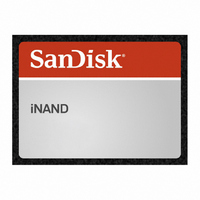SDIN2C2-1G-T SanDisk, SDIN2C2-1G-T Datasheet - Page 6

SDIN2C2-1G-T
Manufacturer Part Number
SDIN2C2-1G-T
Description
IC INAND FLASH 1GB 169FBGA
Manufacturer
SanDisk
Datasheet
1.SDIN2C2-1G.pdf
(29 pages)
Specifications of SDIN2C2-1G-T
Format - Memory
FLASH
Memory Type
FLASH - Nand
Memory Size
8G (1G x 8)
Speed
50MHz
Interface
SD/SPI Serial
Voltage - Supply
2.7 V ~ 3.6 V
Operating Temperature
-25°C ~ 85°C
Package / Case
169-FBGA
Lead Free Status / RoHS Status
Lead free / RoHS Compliant
Available stocks
Company
Part Number
Manufacturer
Quantity
Price
Revision 1.1
© 2007 SanDisk Corporation
1.5
1.6
1.7
1.8
1.9
Functional Description
Technology Independence
Defect and Error Management
Wear Leveling
Automatic Sleep Mode
The SanDisk iNAND contains a high-level, intelligent subsystem as shown in Figure 1-1.
This intelligent (microprocessor) subsystem provides many capabilities not found in other
types of memory cards. These capabilities include:
•
•
•
•
The 512-byte sector size of the SanDisk iNAND is the same as that in an IDE magnetic
disk drive. To write or read a sector (or multiple sectors), the host software simply issues a
read or write command to the card. The command contains the address and number of
sectors to write or read. The host software then waits for the command to complete.
The host software does not get involved in the details of how the flash memory is erased,
programmed or read. This is extremely important because flash devices are expected to get
increasingly complex in the future. Because iNAND use an intelligent on-board controller,
host system software will not need to be updated as new flash memory evolves. In other
words, systems that support iNAND technology today will be able to access future SanDisk
devices built with new flash technology without having to update or change host software.
The SanDisk iNAND contains a sophisticated defect and error management system. This
system is analogous to the systems found in magnetic disk drives and in many cases offers
enhancements. If necessary, iNAND will rewrite data from a defective sector to a good
sector. This is completely transparent to the host and does not consume any user data space.
The soft error rate specification for iNAND is much better than the magnetic disk drive
specification. In the extremely rare case that a read error does occur, iNAND has
innovative algorithms to recover the data. These defect and error management systems,
coupled with the solid state construction, give SanDisk iNAND unparalleled reliability.
Wear-leveling is an intrinsic part of the erase pooling functionality of iNAND.
A unique feature of iNAND is automatic entrance and exit from sleep mode. Upon
completion of an operation, cards enter sleep mode to conserve power if no further
commands are received in less than 5 milliseconds (ms). The host does not have to take any
action for this to occur. However, in order to achieve the lowest sleep current, the host
needs to shut down its clock to the card. In most systems, cards are in sleep mode except
when accessed by the host, thus conserving power.
Host independence from details of erasing and programming flash memory
Sophisticated system for managing defects (analogous to systems found in magnetic
disk drives)
Sophisticated system for error recovery including a powerful ECC
Power management for low power operation
PRELIMINARY
1-3
SanDisk iNAND Product Manual
Chapter 1 – Introduction
02/09/07













